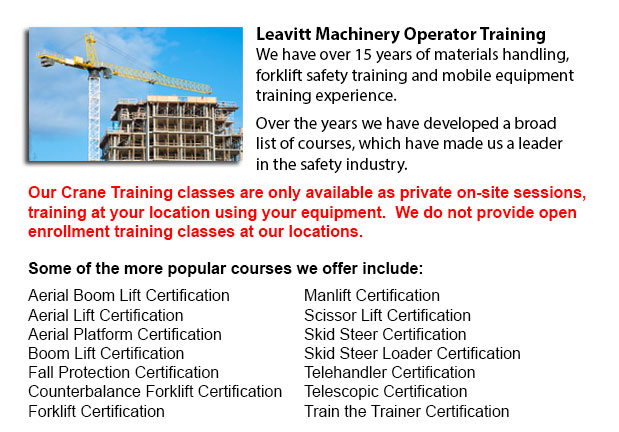
Overhead Crane Safety Training Regina - The overhead crane safety training program is designed to equip the operators with the right knowledge and skills in the areas of: crane safety precautions, materials handling, accident avoidance, and stock and equipment protection. Each of the trainees would get to learn about numerous types of overhead cranes, their capabilities and their uses in different settings. For operators who are licensed and trained, the shift in liability moves to the operator from the company. Thus, the program emphasizes individual operator responsibilities.
The operators in the overhead safety training program will receive instruction about the proper techniques for doing checks: the more detailed in-depth inspection and the pre-shift inspection. These are vital every day routines which must be logged. Properly recorded pre-shift checks help to protect the company from liability in the event of an accident. Pre-shift inspections likewise prevent accidents, damage and expensive repairs. Operators learn how to designate a specific person to perform inspections, how to report problems, and how to maintain the log book.
Each check must be carried out and documented on a regular basis. Things that should be checked for possible problems, include: hooks for cracks, increases in the throat opening, hoist ropes for corrosion, degree of twist, loss of diameter, worn wires, broken wires, kinks and bird caging, chains for nicks and gouges, heat and chemical damage, twists, cracks and corrosion, distortion, excessive wear, pits, stretching, damage from extreme heat.
Operators learn correct rigging measures in this course. Rigging involves understanding the manufacturer's data plate, determining the material weight to be lifted, selecting the gear, and using safe practices to secure the load. The program cover in detail the following: safe working loads, and the capacities of chains, ropes, slings, hooks and shackles.
It is vital to know who may use the cranes at your facility, physical requirements of the job, and operator credentials needed for specialized tasks and permits. Safety should be prioritized when using in the vicinity of pedestrian traffic.
Safe crane use includes responsibilities like for instance checking for hydraulic leaks, undertaking visual inspections, testing the controls, checking the safety guards, examining the hook and hoist rope, braking mechanisms and limit switches. Correct reporting methods are vital. These topics are all covered in depth in the program.
The course likewise consists of the correct moving and lifting procedures with cranes and hoists. Operators would also learn right hand signals. Training includes how to raise the load, attach the load, unhook the slings, abort a lift and set the load.
The steps involved with moving the load, includes: starting and stopping procedures, guiding and controlling the load, observing working conditions and working with signals. In case of power failures, the operator would have to know how to proceed. The course covers techniques for removing the slings and lowering the load, parking the crane, storage equipment, and securing an outdoor and indoor crane.
-
Forklift Training Classes Regina
Forklift Training Classes Regina - Forklifts are a kind of heavy lifting equipment used in order to move and handle material efficiently and safely. Sometimes called Lift Trucks, they are made use of in different industries. Employees working with an... More -
Crane Certification Regina
Crane Certification Regina - The Crane Certification Program covers the industry suggested content which would teach the safe and efficient operation of cranes. The person will train in the following: pre-operational, operational and post operating r... More -
Telehandler Training Courses Regina
Telehandler Training Courses Regina - Employers are responsible for making sure that their operating personnel and supervisors are trained to work proficiently utilizing telehandler machines. The competence level of employees need to be assessed. If... More -
Operator Safety Training, Re-Qualification Training, In-House Instructor Training in Regina
Lift trucks are utilized in just about all industrial construction sites and in warehouse operations and in boat yards. The reach feature of a lift truck is a very important component utilized in a variety of applications like for instance when a she... More -
Heavy Equipment Operator Training Regina
Heavy Equipment Operator Training Regina - Training facilities that offer good standards in the business and not only provide field performing tasks but additional equipment training are highly sought after. Accredited schools offer students the know... More -
Wheel Loader Operator Training Regina
Wheel Loader Operator Training Regina - Cranes are industrial machines which make use of pulleys or levers so as to lift considerable loads. The Roman people utilized cranes in order to put up big monuments, that means these machines have been existi... More -
Crane Safety Training Regina
Crane Safety Training Regina - Both crane driver as well as their supervisors need to know all the possible problems connected to the operation of an overhead crane. All over North America, there is legislation that provides regulation for the safe o... More -
Scissor Lift Safety Training Regina
Scissor Lift Safety Training Regina - A Scissor Lift is a functional kind of platform that normally moves in a vertical direction. The machinery is capable of this movement due to the use of folding supports that are linked in a criss-cross pattern c... More

Forklift Training Regina
TOLL FREE: 1-888-254-6157
Regina, Saskatchewan
forklifttrainingregina.com
Email Us
About Us



